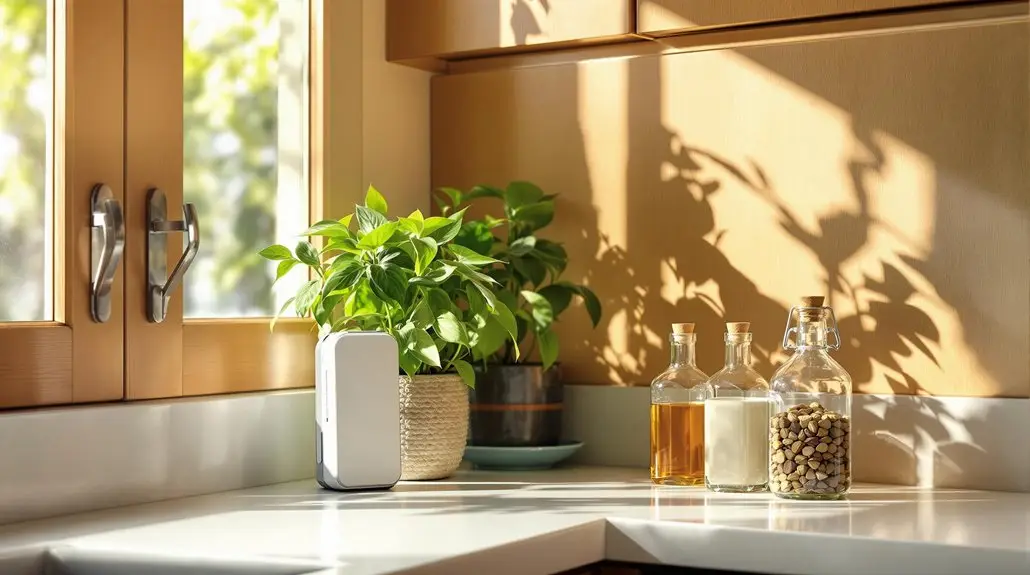To effectively control rats and pests in South Florida, you should conduct thorough inspections of your home, focusing on potential entry points like cracks and gaps. Seal these entry points using durable materials such as steel wool and caulk. Eliminate food sources by storing food in airtight containers and disposing of waste frequently. Consider utilizing trapping methods and natural repellents, such as peppermint oil. Regularly maintain outdoor cleanliness and educate your family about pest detection. Finally, hiring professional pest control services can provide long-term solutions. By following these tips, you’ll be better equipped to manage pest issues efficiently, and more details await you ahead.
Key Insights
- Conduct regular inspections of your home to identify entry points and signs of pest activity, focusing on vulnerable areas like basements and crawl spaces.
- Seal all entry points effectively using materials like steel wool and caulk to prevent rodents and pests from entering your home.
- Maintain strict hygiene by storing food in airtight containers, cleaning spills promptly, and disposing of trash frequently to eliminate attractants.
- Utilize trapping methods strategically by placing traps along walls and in high-activity areas, ensuring they are checked and maintained regularly.
- Hire professional pest control services that use eco-friendly products and provide free estimates to ensure effective long-term pest management solutions.
Conduct Thorough Inspections
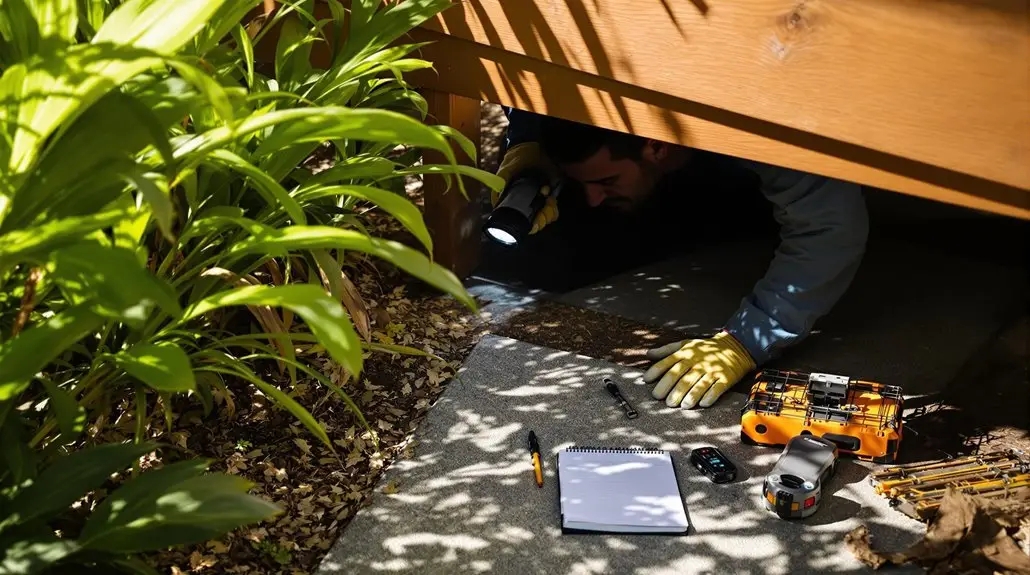
Conducting thorough inspections is essential for effective pest control in South Florida. You should begin your inspection by examining the exterior of your property, focusing on the foundation and perimeter for signs of termite mud tubes, ant trails, or potential rodent entry points.
Next, inspect the siding and eaves for cracks and gaps, as these vulnerabilities can serve as entryways for pests. Pay attention to your landscaping and yard; overgrown vegetation, wood piles, and standing water can create ideal conditions for pest activity. Additionally, integrated pest management practices can be beneficial in identifying and addressing pest issues. Also, check for any wood-to-ground contact, which is a common entry point for termites.
Once you’ve completed the exterior inspection, turn your attention to the interior. Basements and crawl spaces are critical areas to inspect for moisture issues and signs of pest infestation, such as termite damage or rodent droppings.
In your living areas, thoroughly examine walls, floors, baseboards, and ceilings for any indicators of pest presence, including ants or cockroaches. Kitchens and bathrooms require special attention due to their moisture-prone environments; look for leaks and mold that could attract pests. Remember that conducting regular inspections is a key part of preventative pest control.
For a more specialized inspection, focus on wooden structures like framing and cabinetry, searching for signs of termite damage. Utilize advanced tools, such as thermal imaging cameras, to detect hidden moisture issues or pest activity within walls.
This systematic approach not only helps identify current infestations but also aids in recognizing conditions that may lead to future pest problems.
Seal Entry Points Effectively
After identifying potential pest entry points during your inspections, sealing them effectively is your next line of defense. By addressing these vulnerabilities, you can markedly reduce the chances of rodents and other pests infiltrating your home.
Start by examining areas where utility pipes enter your dwelling, along with AC chases, plumbing vents on the roof, and gaps around windows and doors. Pay special attention to any holes in the walls or beneath the garage door, particularly if the garage door seal is damaged. It’s also important to consider the prevalence of rodent populations in your area, as this can inform the urgency of your sealing efforts.
To seal these entry points, consider using a variety of materials suited for different openings. Here are some effective sealing methods:
- Use steel wool to block small gaps and holes.
- Apply caulk to seal cracks and crevices in walls and around windows.
- Install metal sheeting or copper mesh, which prevents rodents from gnawing through.
- Utilize steel hardware cloth for robust sealing against larger pests.
- Employ concrete or mortar for sealing substantial openings.
It’s vital to focus on areas that are a quarter of an inch or larger, ensuring that all accessible entry points are secured. Additionally, remember that rodents carry various diseases, making it crucial to prevent their entry.
Regular maintenance is essential; inspect sealed areas periodically to confirm they remain intact and effective. Additionally, employing entry-limiting screens on pipes and monitoring your property for new vulnerabilities can further protect your home.
Utilize Trapping Methods
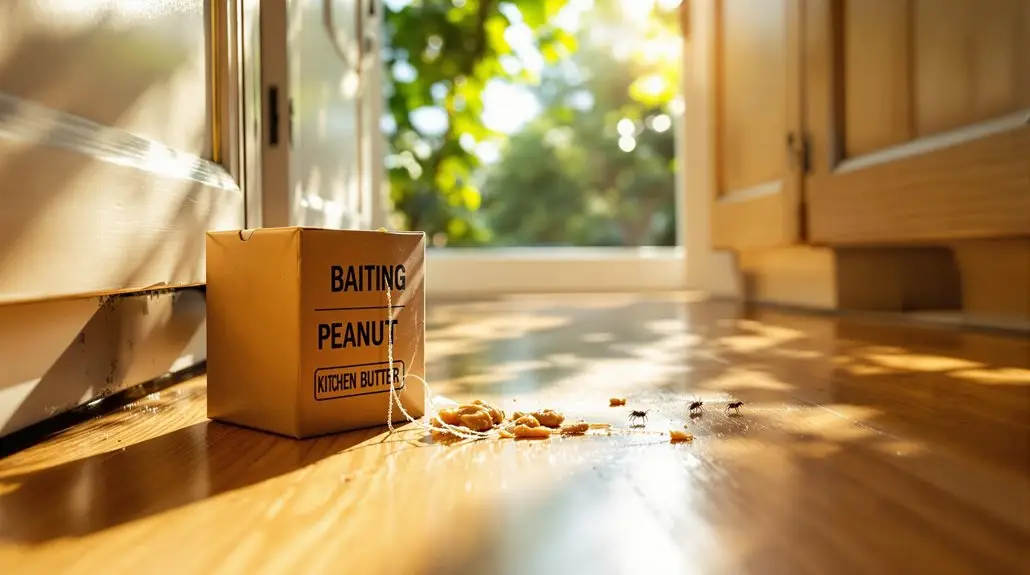
Utilizing trapping methods is vital for effectively managing pest issues in your South Florida home. To maximize the success of trapping, it’s important to identify high activity areas where rat presence is most likely.
Place traps along walls and baseboards, particularly in locations with visible signs of rodent activity, such as droppings or gnaw marks. Position traps at right angles to known rat runways to enhance effectiveness, and consider placing them in attics, behind furniture, or near nesting sites. Norway rats are known for their aggressive behavior, making it essential to monitor and control their populations promptly. Additionally, rodents are notorious for their ability to reproduce quickly, which can exacerbate infestations if not addressed.
Among the various types of traps, snap traps stand out as particularly efficient for catching rats. For best results, you can modify these traps into runway traps by enlarging the trigger.
When setting these traps, use enticing baits like whole nuts, raisins, or peanut butter, as these are known to attract rats effectively. Make sure that traps are placed in areas inaccessible to children and pets, maintaining security within your home.
In addition to snap traps, you might consider using glue traps, which can be effective, especially for mice. These traps should be placed in strategic locations, avoiding dusty or wet conditions to maintain their efficacy.
If you choose to use glue traps, guarantee you use a special glue that remains pliable, allowing it to securely hold the rats. Regularly check and clean these traps to assure continued performance, as this can greatly contribute to your pest control efforts.
Eliminate Food Sources
One of the most effective ways to deter pests in your South Florida home is by eliminating food sources that attract them. Pests, particularly rats, are opportunistic feeders, and they’ll seek out any available food, making it essential to manage food storage and cleanliness. By adopting proper sanitation practices, you can greatly reduce the likelihood of infestation.
To help you get started on eliminating food sources, consider these key actions:
- Store food in airtight containers to prevent odors that attract pests.
- Avoid leaving pet food out overnight, as it can serve as an easy meal for rodents.
- Clean up crumbs and spills promptly, ensuring surfaces are free from food residues.
- Secure garbage cans with tight-fitting lids and take out the garbage frequently to minimize odors and access.
- Remove outdoor food sources, such as fallen fruits and nuts, by picking them up daily.
Additionally, it’s crucial to clean and sanitize areas where rat droppings or urine may be present, using a disinfectant on surfaces in kitchens and pantries. Rats are highly social creatures that thrive in environments with available food sources, so maintaining a tidy environment, both indoors and outdoors, can deter pests by eliminating hiding spots and food sources. Regularly practicing organic pest control methods can also contribute to a safer and healthier home environment. By following these practices, you can create an environment that’s less inviting to pests, helping to protect your home from infestations.
Implement Preventive Measures
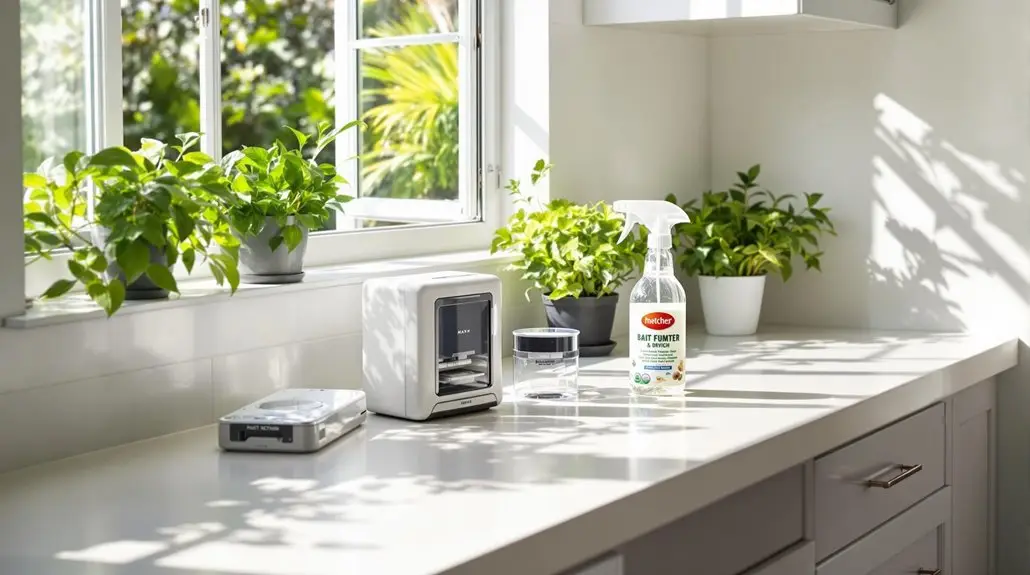
To effectively implement preventive measures against pests, you should conduct regular home inspections to identify any potential entry points or signs of rodent activity. Additionally, educating family members about these practices guarantees everyone understands the importance of maintaining cleanliness and monitoring the home environment. Recognizing the signs of rat infestation, such as droppings and gnaw marks, can further enhance your proactive approach to pest control.
Regular Home Inspections
Regular home inspections are essential for keeping pests at bay in South Florida. By conducting these inspections regularly, you can catch pest problems early, preventing them from evolving into serious infestations that may cause extensive damage and health risks.
During these checks, you’ll identify signs of pests, such as droppings, chewed food containers, or nests, while also monitoring for swarming insects.
Here are key aspects to focus on during your inspections:
- Identify potential entry points where pests could invade your home.
- Check for cracks and crevices in your home’s exterior, sealing them off to prevent pest entry.
- Monitor vulnerable areas like crawl spaces, basements, and attics, which may harbor pests.
- Assess pest activity to evaluate the effectiveness of your current pest control measures.
- Adjust your pest management strategy based on your findings, utilizing traps and baiting stations where necessary. Additionally, consider scheduling regular inspections as they are crucial for identifying wood-destroying pests that may compromise your home’s structural integrity.
#
Educate Family Members
How can you better protect your home from pests? Educating all family members about the risks associated with rodent infestations is essential. Understanding that rodents can transmit diseases and cause property damage can motivate everyone to take preventive measures.
Start by teaching your family how to identify signs of rodent activity, such as droppings, gnaw marks, and nesting materials. One effective way to prevent infestations is to understand that Norway rats are particularly known for their destructive burrowing behavior, which can lead to significant structural damage.
Maintaining a clean home plays a significant role in pest prevention. Encourage regular vacuuming, dusting, and immediate cleanup of food spills. Store food in sealed containers and dispose of garbage regularly to minimize attractants.
Additionally, inform family members about the dangers of rodenticides and stress the importance of keeping these substances out of reach of pets and children.
Equally important is sealing entry points. Teach everyone to inspect and seal cracks and crevices in walls, foundations, and roofs, using materials that rodents can’t chew through.
Finally, familiarize family members with the correct placement of traps and natural repellents, ensuring they understand safety protocols for using chemical repellents.
Consider Natural Repellents
Natural repellents can be an effective way to keep pests at bay in South Florida. Utilizing natural substances not only minimizes chemical exposure for your family and pets, but also disrupts the sensory navigation of pests like rats. By incorporating essential oils, spices, and even household items, you can create a multi-faceted approach to pest control.
Here are some natural repellents to reflect on:
- Peppermint oil: Dab on cotton balls and place them in rat-prone areas, rejuvenating weekly.
- Cayenne pepper: Mix with water and dish soap to create a spray that irritates rats’ noses.
- Lavender plants: Plant around your home or keep in pots to repel rodents naturally.
- Steel wool: Fill gaps and holes to prevent rodents from entering, as it’s hard for them to chew through.
- Apple cider vinegar: Spray or soak cotton balls and place them where rodents might hide.
Implementing these strategies can greatly reduce rodent activity. For instance, peppermint oil and citronella can disrupt their navigation, while cayenne pepper creates an irritating environment. Additionally, using plants like lavender can enhance the aesthetics of your home while also acting as a natural deterrent.
Furthermore, physical barriers, such as steel wool, effectively block entry points, further complementing your efforts. By combining various natural repellents, you create a deterrent that caters to the specific behaviors of pests.
This method not only promotes a more secure home environment but also utilizes the natural properties of substances to achieve effective results in pest control.
Hire Professional Services
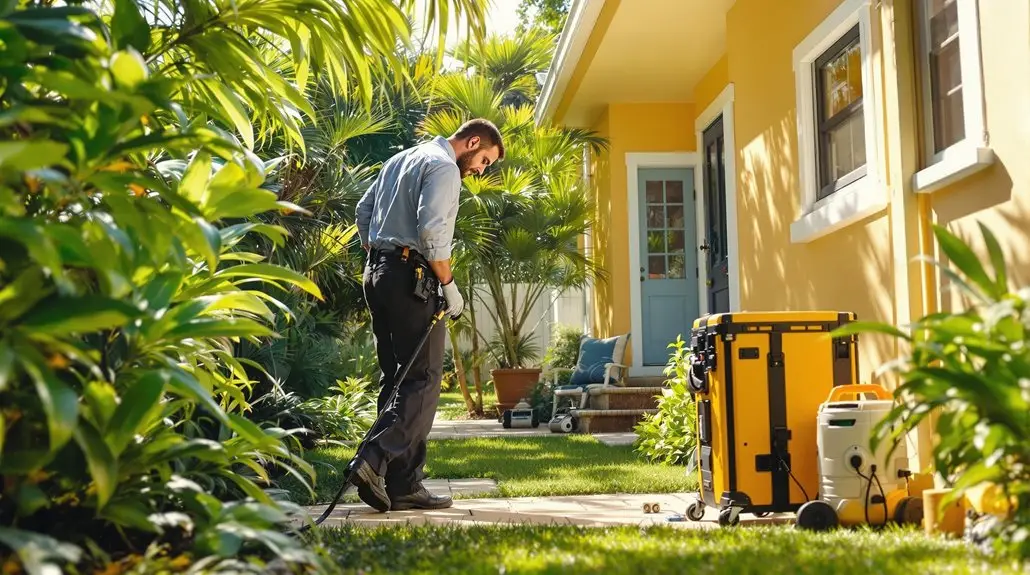
Using natural repellents can be a great first step in pest control, but sometimes the situation calls for a more professional touch. Hiring experienced pest control services can greatly improve your chances of effectively eliminating pest problems in your home.
Companies like Hulett Environmental Services, with over 50 years of experience and a board-certified entomologist on staff, bring a wealth of knowledge to the table. Their trained and certified applicators undergo regular training to stay updated on the best practices in pest management. Additionally, they emphasize customer satisfaction, ensuring that your concerns are addressed promptly and effectively.
When you choose a service, consider those with a strong community presence, such as family-owned businesses like Native Pest Management and Southeast Florida Pest Control, which have long-standing ties to the area.
These companies not only provide a personal touch but also have extensive coverage across multiple counties, including Miami-Dade and Palm Beach.
Customer satisfaction is another essential factor; look for positive reviews that highlight the professionalism and thoroughness of the technicians. Many companies offer free estimates and inspections, ensuring you understand the potential costs before committing.
Additionally, security is paramount; opt for services that utilize eco-friendly and EPA-approved products, ensuring the well-being of your family and pets.
Ultimately, hiring professional pest control services can lead to long-term solutions that are both effective and secure, allowing you to enjoy your home without the worry of unwanted pests.
Maintain Outdoor Cleanliness
To effectively maintain outdoor cleanliness, you should regularly remove debris from your yard, as clutter can create ideal hiding spots for pests like rodents. Properly storing waste in secure containers and ensuring your garbage bins are covered will greatly reduce the chances of attracting unwanted visitors to your home. Additionally, routine inspections can help identify potential pest issues before they escalate, ensuring that your outdoor space remains free from pest problems.
Remove Debris Regularly
While maintaining outdoor cleanliness might seem like a chore, regularly removing debris can markedly reduce pest problems in South Florida. Accumulated debris provides shelter and breeding grounds for various pests, including rodents and insects. By adopting proactive cleaning habits, you can considerably diminish the likelihood of infestations.
To effectively manage outdoor cleanliness, consider implementing the following strategies:
- Regularly sweep and clean patios to remove food crumbs, spills, and other attractants.
- Clear away debris, including leaves and branches, that can harbor pests.
- Empty trash bins frequently to prevent accumulation of waste.
- Clean outdoor furniture to remove spider webs or egg sacs.
- Surface clean outdoor dining areas promptly after use.
In addition to these practices, verify that you eliminate standing water and properly manage food sources, as these factors also contribute to pest attraction.
Properly Store Waste
Properly storing waste is essential for keeping pests at bay in South Florida. To effectively manage your garbage, use metal garbage cans with tight-fitting lids, as these prevent pests from accessing the waste. Guarantee that all trash bins are sealed and strategically placed away from your home to reduce attractants.
Regularly emptying these bins can greatly minimize waste accumulation, which is a primary factor in attracting pests. Additionally, keeping trash bins clean and free of food residues further reduces the likelihood of pest infestations.
Maintaining clean outdoor areas is equally important. Sweep and clean patios consistently to remove food crumbs, spills, and other attractants that can lure pests.
Clear away any items that can collect water, such as flower pots or buckets, to prevent standing water, which attracts insects. After outdoor meals, guarantee that dining areas are left clean to avoid drawing in pests.
Properly managing compost piles and inspecting outdoor furniture for pest activity, like spider webs or egg sacs, are also necessary steps in maintaining a pest-free environment.
## Educate Family Members

Educating your family members about pest control is essential for maintaining a rodent-free home. Knowledge is a powerful tool in preventing infestations and mitigating health risks associated with rodents.
Begin by informing your family about the potential diseases that rodents can transmit, emphasizing the importance of vigilance. Teach them how to recognize the signs of a rodent infestation, such as gnawed holes, chewed objects, paw prints, and unusual odors that may indicate the presence of these pests.
To effectively prevent rodents from invading your home, it’s vital to stress the role of cleanliness. Encourage your family to store food in airtight containers, dispose of trash frequently, and clean up spills promptly.
You should also explain the importance of sealing entry points, which can include gaps around windows and doors, as rodents often exploit these weaknesses to gain access.
Consider discussing the various types of rodents and their behaviors, which can help tailor your control methods more effectively.
Here are some key points to cover with your family:
- Understand the health risks posed by rodents.
- Learn to identify signs of rodent activity.
- Maintain cleanliness to deter infestations.
- Seal potential entry points around the home.
- Recognize different rodent behaviors for targeted control.
Conduct Regular Follow-ups
After educating your family about pest control, it’s important to implement a system for ongoing vigilance. Conducting regular follow-ups is essential in maintaining a pest-free environment.
To start, you should carry out monthly inspections to identify signs of rodent activity, such as droppings, gnaw marks, or nesting materials. Pay special attention to areas around windows, doors, and walls, as these are common entry points for rodents. Additionally, check for potential food and water sources that could attract pests, ensuring you’re removing anything that might entice them into your home.
During these inspections, it’s imperative to assess the effectiveness of your bait stations and traps. If you notice that they’re not working as intended, adjust your strategies accordingly. For instance, consider using a combination of natural and chemical repellents, or reposition traps in areas with high rodent activity, such as along walls or in darker corners.
Moreover, sealing gaps and cracks around windows, doors, and walls is essential to prevent re-infestation. Utilize durable materials like caulk or steel wool, and regularly inspect vents and utility openings for new entry points.
Maintaining cleanliness and hygiene in your home will also minimize the likelihood of attracting rodents; store food in airtight containers, clean up spills promptly, and dispose of trash frequently.
Frequently Asked Questions
How Can I Identify the Type of Rat Infesting My Home?
To identify the type of rat infesting your home, observe specific characteristics.
If you notice a stocky, gray-brown body with a short tail, it’s likely a Norway rat. Conversely, if you spot a smaller, black rat that excels at climbing, it’s probably a roof rat.
Additionally, check for signs like droppings, scratching sounds, and burrows. Understanding these details will help you determine which species you’re dealing with effectively.
What Are the Health Risks Associated With Rodent Infestations?
Imagine a hidden world, where tiny invaders lurk, bringing potential health risks.
Rodent infestations can transmit diseases like Hantavirus and Leptospirosis through their droppings and urine. Additionally, they can contaminate food and water, leading to Salmonellosis.
These pests also carry ectoparasites like fleas and ticks, which can spread serious illnesses.
How Long Does It Take to Eliminate a Rat Infestation?
Eliminating a rat infestation typically takes one to three months, depending on various factors.
If you catch the problem early, it may require only a single visit. However, follow-up visits are often necessary for complete eradication.
The time frame largely hinges on your home’s condition and your cooperation in securing food sources and entry points.
Continuous monitoring for signs of activity is essential to confirm successful elimination and prevent future infestations.
Can Rats Cause Damage to My Home’s Structure?
Yes, rats can cause significant damage to your home’s structure.
Their strong incisors enable them to gnaw through materials like wood, plastic, and even electrical wires, which poses fire hazards. Norway rats might compromise water lines, leading to flooding and costly repairs.
Additionally, their nesting habits can damage roofing and insulation.
Regular inspections, sealing entry points, and maintaining your property are essential steps to prevent these structural issues from arising.
What Signs Indicate a Rat Infestation Is Worsening?
If you think a rat infestation is worsening, you’ll notice several signs.
Increased droppings, intensified gnaw marks, and louder noises in your home suggest higher rodent activity.
Moreover, stronger odors and visible rats during the day indicate a severe problem.
You might also see more nesting materials and multiple nest sites.
In addition, new gnaw marks and larger entry points reveal that rodents are actively expanding their presence, making it essential to address the issue promptly.
The Path to a Pest-Free Home
Successful pest prevention in South Florida hinges on strategic steps that span thorough inspections, effective sealing, and consistent cleanliness. By prioritizing these practices, you not only protect your home from unwelcome guests but also foster a harmonious habitat. Remember, regular follow-ups and education play pivotal roles in pest management. By implementing these proactive and practical measures, you can create a pest-free environment, ensuring your home remains a secure sanctuary for you and your family.
Create Your Pest-Free Sanctuary Today!
Don’t wait until pests invade your home! Take action now with NaturePest Holistic Pest Control, your trusted partner in South Florida for effective and eco-friendly pest management solutions. Contact us today to learn more about how we can help you protect your home and loved ones!

